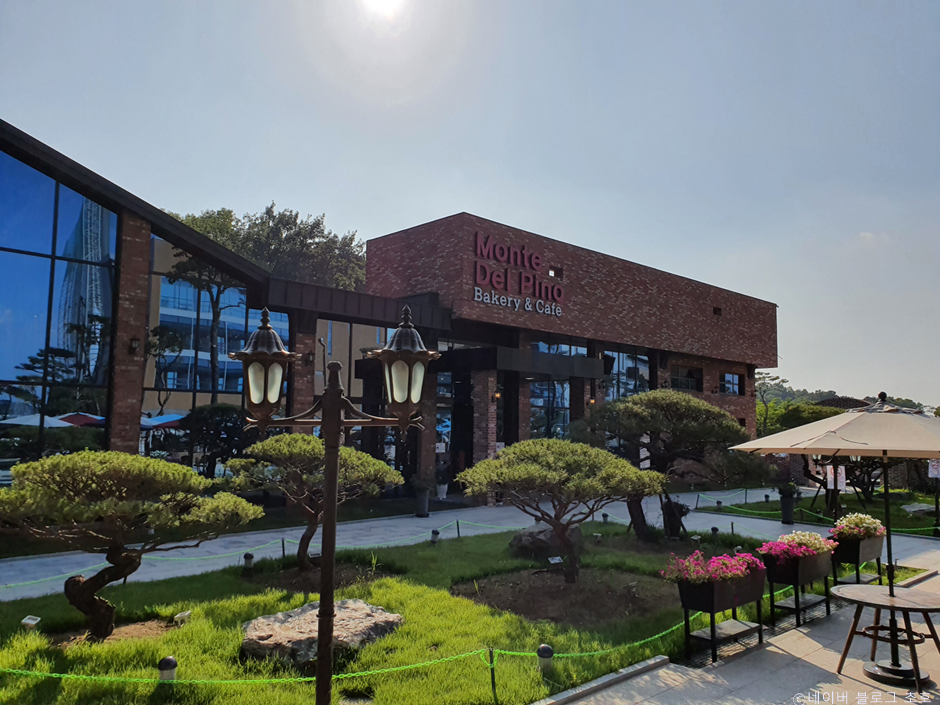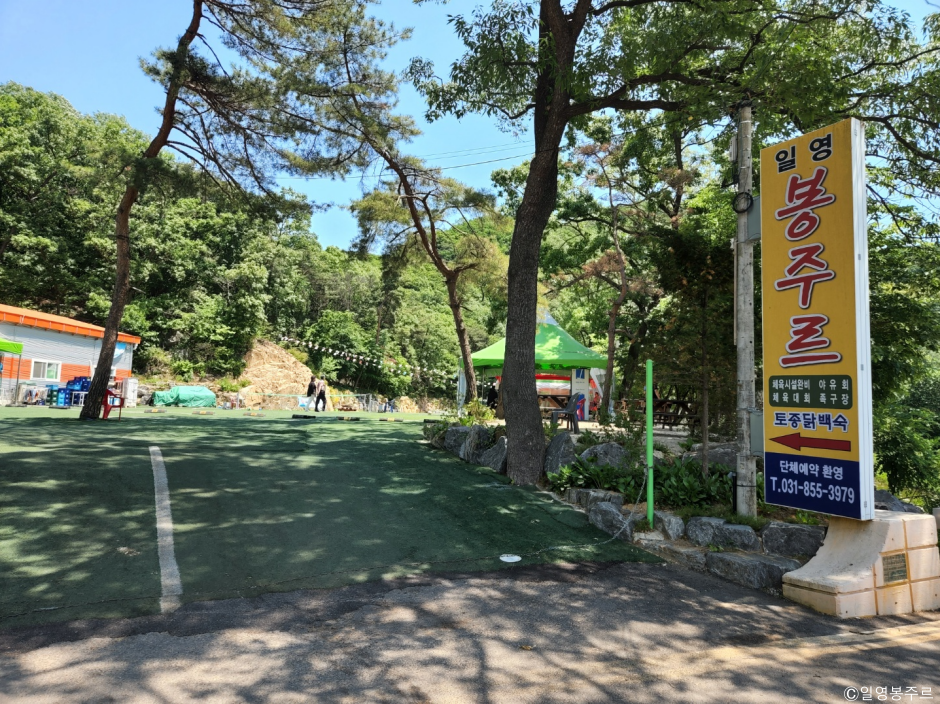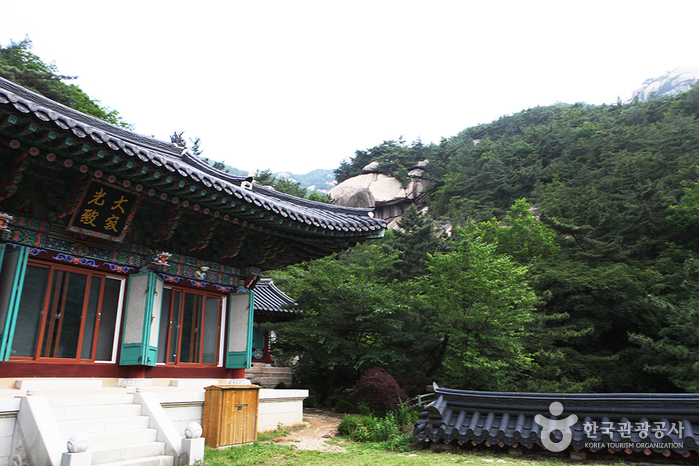Soswaewon Ganjang Gejang Gimpo Main Branch (소쇄원간장게장 김포본점)
13.4Km 2024-02-20
53 Geumpo-ro 1915beon-gil, Haseong-myeon, Gimpo-si, Gyeonggi-do
031-983-8801
Soswaewon Ganjang Gejang Gimpo Main Branch is a restaurant specializing in ganjang gejang (soy sauce marinated crab), housed in a hanok-style building. Ganjang gejang is a Korean dish consisting of live crabs marinated in a seasoning made by boiling various vegetables with soy sauce. In addition to their signature ganjang gejang jeongsik, the sogalbijjim jeongsik (braised beef galbi set menu) is also popular. The set menu includes a main dish, doenjang jjigae (soybean paste jjigae), dolsotbap (hot stone pot rice), and side dishes.
Monte Del Pino (몬떼델피노)
13.4Km 2024-02-21
49-19 Gimpohangang 6-ro, Yangchon-eup, Gimpo-si, Gyeonggi-do
Monte Del Pino is a spacious brunch and bakery café, featuring an expansive outdoor garden and high ceilings. It offers a variety of beverages to complement its basic espresso, as well as an assortment of bread made from organic flour and premium French butter. Their brunch menu includes American brunch platter and eggs benedict. Additionally, they host live performances four times a day, each lasting for forty minutes.
Aramaru Observatory (아라마루 전망대(아라폭포))
13.6Km 2024-02-15
79-4 Duksil-dong, Gyeyang-gu, Incheon
The Aramaru Observatory, a circular structure perched in the gorge section of Gyeyangsan Mountain, occupies the highest point of the Arabaetgil, a maritime path linking the West Sea with the Hangang River. Renowned for offering the most spectacular vista of the entire Arabaetgil, the observatory features a glass floor that provides a stunning overhead view of the Arabaetgil below. At night, the ambiance is further enhanced by the twinkling lights installed along the railings and floor, creating a mesmerizing atmosphere that captivates visitors.
Ilyoung Bonjour (일영봉주르)
13.6Km 2024-02-22
248 Yuwonji-ro, Jangheung-myeon, Yangju-si, Gyeonggi-do
Ilyoung Bonjour is a restaurant located by a valley, offering an ideal setting to enjoy both a meal and water activities. Its key menu item is hanbang dakbaeksuk (whole chicken soup with medicinal herbs). It is served as a set menu that includes samgyeopsal (grilled pork belly), haemul pajeon (seafood pancake), and dotorimuk (acorn jelly salad). Amenities include an indoor swimming pool, a valley side for a refreshing dip, and a foot volleyball court. The water facilities are complimentary for guests who order a meal.
World Cup Park (월드컵공원)
13.8Km 2024-10-23
243-60 World Cup-ro, Mapo-gu, Seoul
Opened on May 1st, 2002, the Wolrd Cup Park was once a 15-year-old landfill that held over 92 million tons of garbage. The park is located near Seoul World Cup Stadium, and is made up of five smaller parks - Pyeonghwa (Peace) Park, Haneul (Sky) Park, Noeul (Sunset) Park, Nanjicheon Park, and Nanji Hangang Park.
* Pyeonghwa Park: Closest to Seoul World Cup Stadium, it holds a pond, garden, children’s playground, and forest. As a representative park of World Cup Park, the park was designed in hopes of peace and harmony between mankind and nature. It is often used as a picnic area and place for nature studies.
* Nanji Hangang Park: Nanji Hangang Park was developed on the banks of the Hangang River. In contrast to other Hangang River parks, Nanji Hangang Park is a water-friendly park that has a gradual slope towards the riverbank. The park consists of a camping ground, soccer field, basketball court, grass field, cruise ship port, and an area for nature studies.
* Haneul Park: Haneul Park consists of vast grassland located at the highest elevation of the five parks. The park's pasture is covered with eulalias and wild flowers in their most natural state. In addition, 30,000 butterflies of different species were introduced in 2000 to stabilize the ecosystem. Five wind-powered generators provide power to the park and the park’s maintenance office. Once a mountain of garbage, it is now a green hill with 22 lookout points offering breathtaking views of Seoul, including the N Seoul Tower, Bukhansan Mountain, and Hangang River. Tall trees are line the park to provide shades and serve as resting spots for visitors. As a popular spot to enjoy the sight of eulalias, the park usually remains open until late in the evening during the Eulalia Festival period.
* Noeul Park: In order to prevent the vast area of land of what was once a wasteland from becoming an unnecessary chunk of land, a nine-hole golf course was constructed in what is now known as Noeul Park. The golf course serves as an environment friendly entertainment park to visitors while stabilizing the geographical formation and has an urban park nearby that offers scenic views of the Hangang River and beautiful sunset. Located west of the golf park is Noeul Square, decorated with shrubs and flowers.
* Nanjicheon Park: Nanjicheon Park was developed from the Nanji Stream, which flowed under Haneul Park. It was once overflowing with sewage runoff from a nearby landfill, but it has since been beautifully restored into a park with clear water. The park is built to serve as a recreational spot for those with for youths, elders, and people with disabilities.
E-Mart - Sinwol Branch [Tax Refund Shop] (이마트 신월)
13.8Km 2024-04-22
59, Hwagok-ro, Yangcheon-gu, Seoul
-
Olive Young - Deungchon Branch [Tax Refund Shop] (올리브영 등촌)
13.8Km 2024-04-18
1F, 20, Mokdongjungangbuk-ro 7-gil, Yangcheon-gu, Seoul
-
Gleen Park (글린 공원)
13.9Km 2024-02-20
34 Seongmo-ro 5beon-gil, Yangchon-eup, Gimpo-si, Gyeonggi-do
031-996-5177
Gleen Park is a café that harmoniously blends various plants and decorations. The first floor offers a camping-like ambiance, complete with artificial grass, camping tables, and chairs. On the second floor, a picnic atmosphere is created with hammocks and rocking chairs. The café's signature menu item is the Original Misu, a misutgaru latte (roasted grain powder latte) made using grain power ground in-house.
Olive Young - Mapo-gu Office Station Branch [Tax Refund Shop] (올리브영 마포구청역)
13.9Km 2024-04-16
196, World Cup-ro, Mapo-gu, Seoul
-
Seoul Geumseonsa Temple (금선사(서울))
14.0Km 2021-08-17
137, Bibong-gil, Jongno-gu, Seoul
+82-2-395-9911
Geumseonsa Temple is located within Bukhansan National Park, just behind Cheong Wa Da (The Blue House) and Gyeongbokgung Palace. The entrance to the temple is just off the hiking path to Bibong Peak.
After passing Banyajeon Hall, where Buddhist services are held, visitors will see a pine tree over 200 years old, and beyond that, a staircase with 108 steps leading up to Daejeokgwangjeon Hall in the temple's main area. To the right is Samseonggak House and Hongyegyo Bridge over the clear waters flowing down from the mountain.
Additional temple buildings include Mitajeon Hall and Yeonhwadang Hall, built in 2004 by Monk Beopan; and Jeokmukdang Hall, built using traditional construction techniques.



![E-Mart - Sinwol Branch [Tax Refund Shop] (이마트 신월)](http://tong.visitkorea.or.kr/cms/resource/20/2880120_image2_1.jpg)
![Olive Young - Deungchon Branch [Tax Refund Shop] (올리브영 등촌)](http://tong.visitkorea.or.kr/cms/resource/23/2880123_image2_1.jpg)
![Olive Young - Mapo-gu Office Station Branch [Tax Refund Shop] (올리브영 마포구청역)](http://tong.visitkorea.or.kr/cms/resource/33/2888433_image2_1.jpg)

 English
English
 한국어
한국어 日本語
日本語 中文(简体)
中文(简体) Deutsch
Deutsch Français
Français Español
Español Русский
Русский